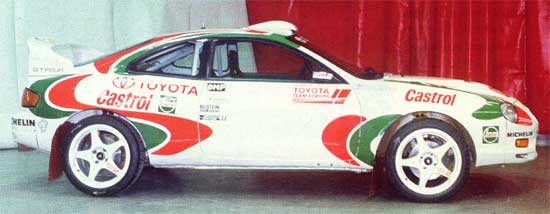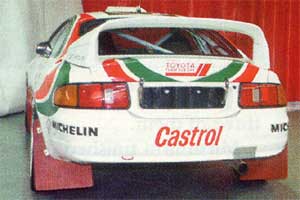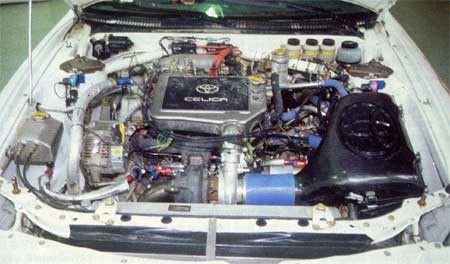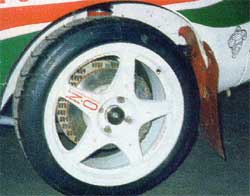|
Toyota Celica ST205 WRC |
|
Taken from Rally Sport April 1995 Toyota has unveiled its ST205 rally car, the latest-generation Celica
designed with this year's WRC events in mind. Martin Holmes takes a
closer look. We spoke to Toyota Team Europe's engineer Dieter Bulling, who explained how it's hoped the transverse-engined model will keep the team competitive with longitudinal-engined cars in the next few years of WRC competition. The car's most striking feature is its high-mounted rear wing to give improved aerodynamics.
"The outside body shape has been cleaned up to improve the drag coefficient, as well," explains Dieter, "but the main difference is the wing, which allows more down-force at the rear. Often engine cooling is more difficult if the drag coefficient is reduced but we are quite happy with the air inlet openings in the front of the car (a little bigger than on the existing model) and we expect the same cooling efficiency as we have at the moment. "To allow air to escape there is an opening in the bonnet once again (again a little bigger), and there is more space between the water radiator and the engine block. The radiator has been brought further forward, and this allows a better airflow inside the engine compartment. And the engine itself is a little more to the rear as well but this doesn't interfere with the balance of the car." The purpose of the rear wing is to correct the inherent balance disadvantage of a transverse-engined car compared with longitudinal-engined models like Fords and Subaru's. The aerofoil has been designed to minimise drag losses while still increasing the downforce and it is effective from 100-120 kph upwards. "We get better traction and it makes the car more stable. The wing has two positions, up and down, with removable distance pieces. In the Japanese market it will be sold with the wing in me up position and the pieces in place, but to help transport the export cars the pieces will be removed and stowed in me boot ready to fit on arrival. "We are expecting to sell around 2500 examples in Japan alone with the pieces in place. The amount of downforce is influenced by ride height and we still have to carry out wind tunnel tests, but it's expected that there will be 50 kg of downforce at 100 kph with the wing in the up position, and maybe five times more than that with the wing at the low position." Development of the front suspension is still continuing. There will be a modified McPherson system and the rear will be adjusted to balance these changes and make the car more agile when turning-in to comers.
"The pickup points for the lower arms are different and instead of mounting directly to the bodyshell we now have an additional subframe which is part of the new chassis design. The rules say the subframe is free - but only if you have one in the first place!" Toyota now joins Lancia and Ford in using 16 in wheels as standard. "There are two reasons for this," says Dieter. "Bigger brakes for GpN, which is very important, and using 18 in wheels for asphalt events in GpA. Because we have a limit of 650 mm total diameter of tyres, it means we have to use lower tyre side walls. These lower-profile tyres also make the car more agile on asphalt. "For gravel we still expect to keep to the 15 in diameters we used previously. We will be testing 16 in wheels for rallies like the 1000 Lakes and maybe New Zealand, but that decision is also influenced by what the tyre manufacturers can supply.
"We also want greater sidewall stiffness. The ATS development is continuing - Michelin solved the problems they had at the beginning (of 1993) with asphalt tyres. We want 18 in tyres for asphalt to increase performance, though we are quite happy with the performance of our brakes as they are. TTE is not planning to use bigger brakes at this time. Although it is possible to fit the bigger355 mm diameter discs, which are narrower in rubbing area and therefore no heavier than the current 343 mm ones, they are still suspect for cracking. One- block aluminium callipers will still be used. The concept of having the standard car's chassis made stiffer was to avoid the problem of reinforcing the chassis floor when the rally car bodies were prepared.
"It was a matter of obtaining the correct relation between overall torsional stiffness and the stiffness of the side forces on the floor pan. This is now improved by stiffening the longitudinal floor ladder. The bodyshell weight of the new car is similar to the existing one, maybe one or two kg heavier, but we don't have to add so much weight with extra welding." Basically the engine is the same as before. It retains the twin-entry port-induction system to improve response oft he turbo but it will be water-injected like the Ford system and will be fitted to all production cars. "The reason is to have cooler inlet air, so you reach the knocking point in the engine later and go closer to the limit with the ignition setting. This will help reliability and give maximum power, as well as helping to cool the engine as a whole. The original air temperature doesn't influence the effect of the system too much but there will definitely be a bigger advantage in hotter weather. If you compare the inlet air to the ambient temperature, the inlet air is always much higher. "There are minor production changes to fulfil exhaust and ignition requirements as well. The intercooler is still the same." The transmission is also the same. For the production car there is a limited slip differential and the gearbox casing is reinforced, which will make things better in GpN. In rally form there will be the same mechanical systems in the front and rear and a viscous system in the middle.
1992. The main tuning work is to find the right friction rate and ramp angles in the front and rear differentials, and then vary the setup of the basic viscous coupling accordingly. "The handling of the new car (because of the suspension changes) is different, which means that we have a lot of work to do again on these differentials. We want the suspension changes to give us more grip in front and this will influence what we do with the central differential. "Toyota has never had a policy of providing support for GpN customers, certainly there was never a sport parts In addition to the usual gearbox oil cooler there will be ones for the steering pump (when required), rear differential (again not for every rally), and for fuel. This is to overcome the problems of low boiling point of the control fuel and is an air-to-air cooler that can also be air-cooled if necessary. The rally version of the car was first run just before Christmas 1993 at Valkenswaard in Holland and then in France with test driver Marc Deuz at the wheel, mostly on gravel. He reported the car seemed to provide a very good basis for development and initial handling was good. The ST205 was launched as a production car on February 2, and basic homologation is scheduled for April 1and the car is due to appear in competition in August. The test schedule is to concentrate first on the gravel development and, with the Celica's anticipated absence from San Remo, it's expected that asphalt development can wait until later. For a further page on Toyotas illegal turbocharger, click here. |
| [ home | site map | back | forward | top ] |



